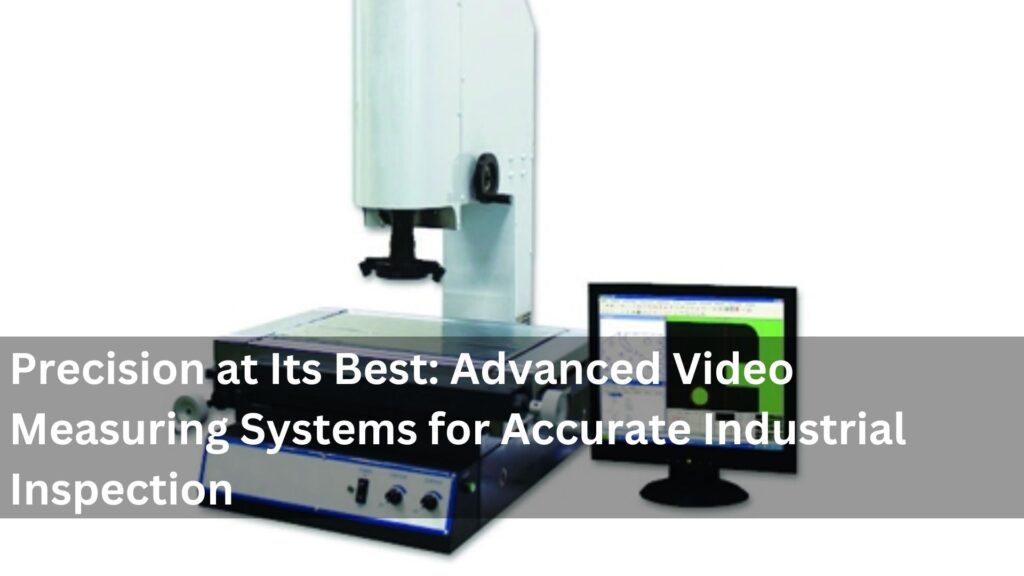In today’s fast-paced and highly competitive industrial environment, precision and accuracy in measurement are not just advantageous – they are essential. Video measuring systems have become an integral part of quality control in various industries, offering non-contact, high-resolution, and extremely accurate measurements for a wide range of applications. From electronics and automotive components to medical devices and aerospace parts, these systems play a critical role in ensuring product consistency, regulatory compliance, and operational efficiency.
As industries continue to demand tighter tolerances and faster inspection times, video measuring systems offer a sophisticated solution that bridges the gap between traditional measurement tools and modern automated technologies. This article explores the key features, applications, and benefits of video measuring systems, and why they are becoming a standard in precision measurement.
What Are Video Measuring Systems?
Video measuring systems are advanced optical instruments used to inspect, measure, and analyze the physical dimensions of objects using high-resolution cameras and digital processing. Unlike traditional mechanical tools, they utilize non-contact vision technology, which minimizes the risk of damaging delicate or small components. These systems often integrate computer-aided measurement software, lighting control, motorized stages, and even 3D capabilities.
By combining imaging and measurement technology, video measuring systems offer a fast and reliable way to achieve micron-level accuracy in various production and R&D settings. Their adaptability and user-friendly interfaces make them accessible even for operators without extensive metrology training.
Key Features of Video Measuring Systems
One of the defining aspects of video measuring systems is their precision. These systems commonly include:
High-resolution digital cameras
Zoom optics or telecentric lenses
Integrated lighting (ring light, coaxial, and backlight)
Motorized X, Y, and Z axes for 3D measurements
Advanced measurement software with auto-recognition and reporting features
The combination of these elements allows for repeatable and accurate measurements in both 2D and 3D spaces. Whether checking the flatness of a surface or the depth of a micro-cavity, video measuring systems deliver results with minimal human error.
Applications of Video Measuring Systems Across Industries
Video measuring systems are widely used in industries where dimensional accuracy is critical. Common sectors include:
Electronics: Inspecting printed circuit boards (PCBs), microchips, and connectors
Automotive: Measuring engine components, gears, and injection parts
Medical Devices: Ensuring precision in implants, catheters, and diagnostic tools
Aerospace: Verifying the geometry of turbine blades and structural parts
Plastic Molding: Analyzing injection-molded parts for warping or defects
These systems streamline the inspection process, allowing manufacturers to quickly identify and address defects before products reach the next stage of production or the customer.
Benefits of Using Video Measuring Systems
The benefits of implementing video measuring systems in industrial settings are numerous:
Non-Contact Measurement: Reduces wear and risk of damaging components.
High Accuracy and Repeatability: Essential for parts with tight tolerances.
Time Efficiency: Faster than manual tools, improving production throughput.
Digital Reporting: Automatic data collection and generation of inspection reports.
Scalability: Suitable for single-part inspection or integration into automated production lines.
By incorporating video measuring systems, companies can enhance their quality control capabilities while saving time and reducing labor costs.
Comparing Video Measuring Systems to Traditional Methods
Traditional measurement tools such as calipers, micrometers, and CMMs (Coordinate Measuring Machines) are still widely used. However, they have limitations in terms of speed, complexity, and the ability to measure small or fragile parts. Video measuring systems offer a superior alternative by providing:
Faster inspection cycles
Better documentation and traceability
Enhanced ability to measure complex geometries
Reduced operator dependency and error
While CMMs are effective for larger components, video measuring systems are ideal for small to medium-sized parts requiring high precision.
Automation and Integration Capabilities
Modern video measuring systems are increasingly equipped with features for automation and integration into smart manufacturing systems. These include:
Robotic part loading and unloading
Integration with MES (Manufacturing Execution Systems)
Barcode/QR code scanning for part identification
Real-time SPC (Statistical Process Control) data output
Such capabilities make video measuring systems a key component of Industry 4.0 initiatives, supporting predictive maintenance, process optimization, and real-time quality monitoring.
Selecting the Right Video Measuring System
When choosing a video measuring system, it’s important to consider the specific requirements of your application. Factors include:
Measurement accuracy and range
Part size and geometry
Software usability and compatibility
Budget and ROI
Leading manufacturers offer a variety of models with customizable options, so businesses can find a system that fits their unique production needs.
Training and Support for Video Measuring Systems
Implementing video measuring systems also involves proper training and support. Top suppliers provide:
On-site and online training sessions
Technical support and maintenance services
Calibration and certification
Ongoing support ensures that your measurement process remains accurate, compliant, and efficient over time.
Conclusion
In a world where precision matters more than ever, video measuring systems offer the perfect blend of speed, accuracy, and versatility. Their wide range of applications across industries and ability to integrate with automated systems make them a smart investment for any manufacturer seeking to improve product quality and reduce inspection time.
By adopting advanced video measuring systems, companies can stay competitive, meet stringent quality standards, and embrace the future of digital manufacturing with confidence.
Author
-

Becky Fung is a seasoned digital marketing expert with 15 years of experience driving growth across Singapore, Malaysia, Australia, and Hong Kong. With a strong background in editorial and research, she specializes in analyzing marketing trends across fintech, eCommerce, and the evolving crypto landscape. Passionate about data-driven strategies and emerging digital trends, Becky shares in-depth insights to help businesses stay ahead in the fast-paced digital world.
View all posts










